

FORMS OF PROCUREMENT – COMMUNICATIONS AND CONTRACTUAL RELATIONSHIPS
Having now examined the risks that need to be considered when choosing the form of procurement to be used in your project, it is useful to examine the communications between the parties to, and involved with, the contact and what is contractual relationships between those parties. Understanding these communications and relationships will greatly assist when we come to examine the specific forms of contract that we are likely to use in each particular case.
Traditional “build only” procurement
The traditional process shown below involves the Employer/Owner in separate relationships with each of its consultants whose task it is to prepare the design and specification or bills of quantities. The Contractor’s job is then to carry out the designed work under the direction of the Architect/Engineer.
Communications Contractual Nexus
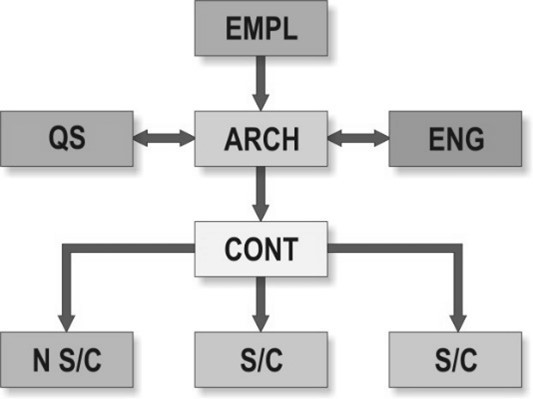
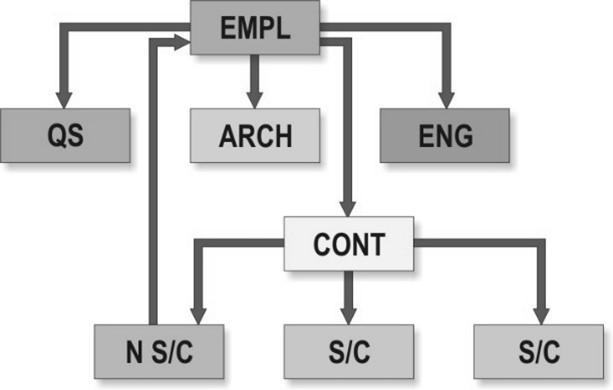
Thus the essential features of what has sometimes been called “general contracting” are the existence of the Employer/Owner, the Contractor and possibly subcontractors and the separation of the design elements of the process from the construction elements. In this form of procurement the Contractor and the designers (and sometimes a project manager) are employed directly by the Employer/Owner, but under separate contracts. This is usually characterized by the appointment of an Architect/Engineer who is the Employer/Owner’s agent but who has an obligation to act fairly in certifying payments, extensions of time, completion etc.
Communications Contractual Nexus
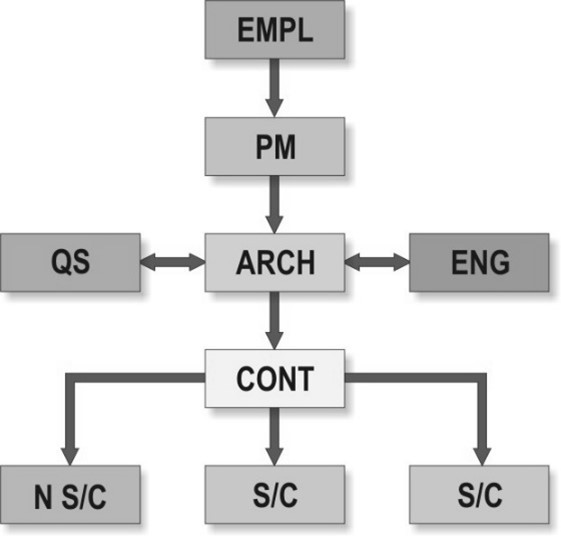
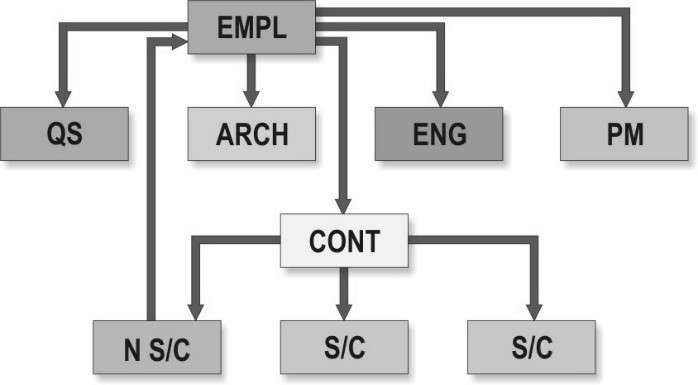
Where in fact the Employer/Owner comprises a multiplicity of end users, communications can be improved by the appointment of a project manager to act as interface between the Employer/Owner and the design team. The project manager then acts as a useful single point of focus for
This method offers the advantage of independent professional advice, and hence controls of quality of the building process and also makes the introduction of variations as the work proceeds relatively easily and controllable. Variations can be priced directly on the basis of rates quoted for the various categories of labour and materials in the contract bills of quantities. Variations of this traditional procurement process are commonly used whereby tenders are detailed on the basis of bills of approximate quantities, or on a specification and drawings only basis without bills of quantities where the Contractor has to take off its own quantities. This sometimes enables part of the construction activities to be run in parallel with contracts offering potential savings on pre-contract time, but with this method the attendant risk of voluntary change in the construction period is enhanced.
The traditional “build only” method of procurement is intended to be a linear approach to the various processes in producing a building. Savings in time over the linear approach can be made by parallel processing of the design and construction process, but at a risk. All parallel processing carries with it a degree of risk proportionate to the degree of overlap, but is often easier to achieve and at less risk than in other methods of procurement.
The time shortening process of producing bills of quantities, whilst the architect or engineer produces the design, so that the essentially linear process of the production
On the other hand the preparation of bills of approximate quantities for negotiation and selecting a contractor whilst the detailed drawings are being prepared does tend to save time and to enhance effective contract management, since the contractor can effectively use the time taken in completing the design to organize and prepare for the project and to incorporate the work of subcontractors in the programme whilst it proceeds with the site establishment.
The principal influences on the incidence of delay in traditional “build only” contracts have been found to be:-
Essentially all of these come as a result of inadequate pre-contract preparation of the design. However, experience also shows that a failure to appreciate, or take responsibility for the requirements of an efficient interface between the Contractor’s work and the specialist subcontractor’s work (whether under standard subcontractor forms or bespoke forms) is also a major source of failure in traditional procurement methods.
Whilst it is self-evident that delay due to unforced errors or omissions should be avoided, in this form of procurement the Architect/Engineer must have sufficient opportunity to complete the design and ensure that it is fully coordinated before the contactor starts work on site as it can only lead to financial disaster if the design is not completed before the contractor does so. Indeed any Architect/Engineer who fails to warn the Employer/Owner of the inadequacy of incomplete design
There are essentially two forms of “build only” contracts:-
The theory behind a lump sum contract is that the risk as to fluctuations in cost and time falls on the contractor because the price and contract period is predetermined. Therefore, in theory, the contractor is neither entitled to further payment if the work costs it more to complete than it estimated, nor may it have more time to complete if the work takes longer. That theory, however, becomes little more than superstition in relation to the rigidity of price and time under the standard forms of construction contract where the risk of virtually every change is borne by the Employer/Owner.
A re-measurement contract is for use in connection with projects where it is impossible or very difficult to formulate a complete design before the commencement of the work on site. It usually relies on a “fixed fee” or approximate quantities method of tendering and is normally used because the Employer/Owner is either:-
Where the contract relies on a definition of the works such as a fixed fee form of contract, the definition becomes critical and if such definition cannot be defined with accuracy, it may well be dangerous to invite contractors to tender on a fixed fee to cover all their overheads and profit. Inevitably, as the scope changes, their fee will increase and this may lead to spiraling of costs and claims.
“Design and build” procurement
Under a “design and build contract” the contractor takes the lead role and is responsible to the Employer/Owner for both the design and construction of the works. The communications and contractual relationships are illustrated below. The nature of the responsibility can range from a duty of reasonable skill and care in carrying out design services to that which in a “turnkey” contract can amount to an absolute obligation to ensure that the facility is fully functional or meets certain specified performance criteria, often referred to as “fitness for purpose” liability or “ready to occupy“ status.
Communications Contractual Nexus
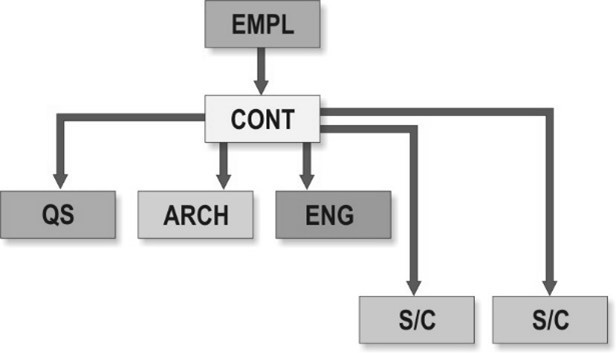
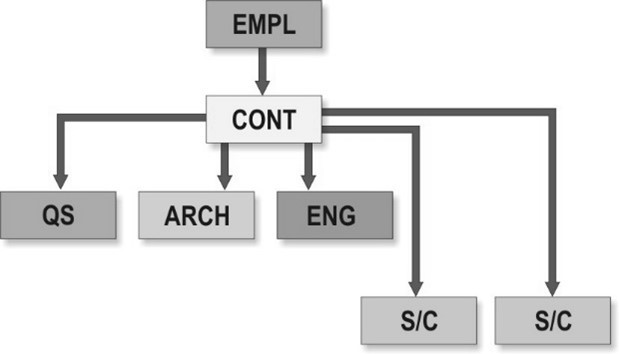
Before any “design build” tenders can be worked, the Employer/Owner must produce its statement of requirements or design criteria and will require professional advice to make sure that these are adequately specified. It is important in this respect that the Employer/Owner’s requirements are unambiguous and provide for the standard of work required. The risk of errors in the conceptual design is likely to reside with the Employer/Owner. In some circumstances, the contractor may agree to accept responsibility for elements of the project design originally prepared by the Employer/Owner.
Cost control of a “design and build” project is likely to be easier than in a traditional contract structure, particularly since, in comparison with a traditional contract, there should be fewer events entitling the contractor to extensions of time and loss and expense. It may, however be difficult to ensure value for money, and control of detailed specifications and quality can become difficult, since the detailed design is under the contractor’s control.
The contractor’s design liability, in addition to liability for the quality of workmanship and materials, potentially increases tender prices, but, on the other hand, the contractor has greater control over the interface of the design and construction functions. In theory, this leads to greater efficiency and, from the Employer/Owner’s point of view, a single point of liability. Thus if there is a building failure or delay in completion, the Employer/Owner does not have to ascertain whether the architect, engineer or contract administrator is responsible (even though the contractor may have to!)
This form of procurement does not, however, relieve the Employer/Owner of all the risk. First it is difficult for the Employer/Owner to evaluate tender prices because the tenderers may have produced different design solutions which are not easy to compare. Secondly, it is more difficult to ensure that under-design is not incorporated into the specification and that low-grade workmanship does not occur on-site.
The principal reasons for delay in “design and build” contracts appear to be quite similar to the sort of risks that attend the traditional form of contracting. The only significant differences seem to be that the Employer/Owner is unlikely to have access to the contractor’s planning and progress records, rendering it more difficult to defend against claims and global claims. And disputes regarding design defects will be between the contractor and its architect and engineer, rather than between the Employer/Owner and its architect or engineer.